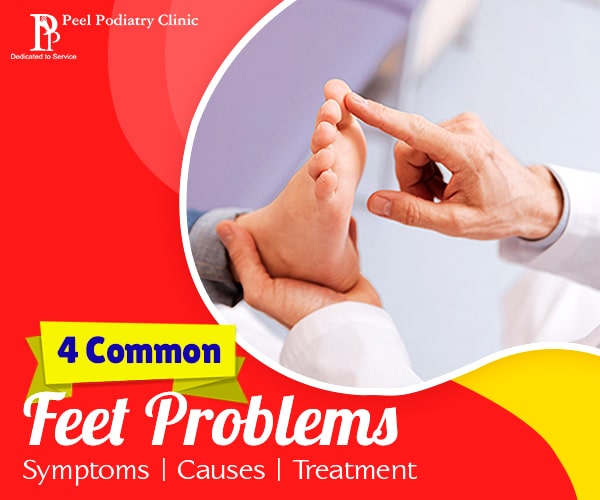The feet are often overlooked and underestimated by many of us. However, it serves a range of functions to help us move. From standing to walking, running, jumping, climbing and a lot of other activities are possible just because of our feet. We misconstrue this part of our body and pay scant attention at the right time. Though the foot is inherently one of the robust parts of the human body, it can undergo several ailments and problems resulting in severe pain and discomfort.

What are the primary foot problems?
1. Athlete’s foot
This is a common foot problem where the skin between the toes gets affected primarily. This problem is a result of fungal infection of the skin and can spread to different parts of the feet causing discomfort, itching and even burning.
Causes – The most usual cause of this problem is a fungus. The fungus that causes this infection dwells in warm and damp areas. People going barefoot to the gym, swimming pool, etc tends to catch this infection. Other people who wear tight shoes for a long time can be vulnerable to this infection.
Symptoms – The main symptoms of athlete’s foot are itching, blistering, and peeling of the skin on the feet.
Treatment – The easiest way to get rid this infection is cleaning and keeping your feet dry. On the other hand, fungal infections treatment in Mandurah can be extremely beneficial for people suffering from athlete’s foot.
2. Bunions
Bunions are typical abnormalities of the feet in which a small bump is noticed around the large toe joint. The big toe slightly turns inwards and women are more prone to this ailment.
Causes – The most common cause of this problem is tight shoes and excessive pronation (rolling-in). Wearing tight shoes can cause the toes to stay under pressure resulting in bunions.
Symptoms – People with bunions often face visible bump on the side of their big toe. Other symptoms include callus or corn formation below the big toe and difficulty while trying to bend the big toe.
Treatment – The treatment of bunions should be initiated by wearing wider fitting shoes. Early intervention with foot orthoses can help. In the later stage/advanced bunion deformity, surgical intervention may required.
3. Blisters
Blisters are very common in people of all ages. Most people are likely to experience blisters at least for once in their lifetime. These are small fluid-filled sacs that form on the skin of the feet.
Causes – Blisters commonly appear due to continual friction of a particular part of the feet with shoes. Most often wrongly-fitting shoes and walking/running for a long time can be the primary cause of blisters.
Symptoms – Blisters do not manifest lots of symptoms but the most prominent indication is a fluid-filled sac on the skin of a certain area.
Treatment – The best way to deal with blisters not rupturing them. They often heal on their own and applying a light bandage can sometimes give relief.
4. Corn
Patches of thick skin forms on the soles of the feet. They are known as corns. They start painless but can grow to become painful in some cases. Our body encourages these formations in order to protect the skin from developing blisters.
Causes – Corns form due to constant pressure and friction in certain areas of our feet. Other reasons might include hammer toe, wrong shoes, bunions, etc.
Symptoms – The only symptom of corns are hardened skin in parts of feet. They may start painlessly but may grow to be painful.
Treatment – Gentle debridement/parring in adjunct with good footwear advise from a podiatrist is normally sufficient to manage the condition.
Conclusion – These are some of the common feet problems. People often report about these problems and fortunately, there are effective treatments for complete recovery from these ailments. If you are unsure about any feet condition, going to a podiatrist from Mandurah is highly advisable.
